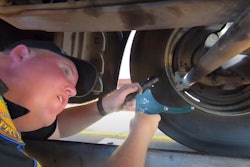The following was published in CCJ's Air Brake Book, 11th edition, sponsored by SilverbackHD. CCJ's Air Brake Book is a complementary industry resource, courtesy of our partnership with SilverbackHD, the Technology and Maintenance Council and Commercial Vehicle Safety Alliance. You can download the entire Air Brake Book here.
Brake linings should be replaced before they completely wear away – resulting in metal-on-metal contact between the brake shoe and the brake drum, which causes potentially catastrophic component failures and expensive replacement costs.
Replacing linings in a timely fashion also will prevent the possibility of S-cam turnover.
It is widely accepted that brake linings worn down to a quarter-inch thickness are in need of replacement. Carefully measuring lining thickness is recommended, but if you are performing a visual inspection, look for lining thickness that is slightly higher than the rivet heads that secure it to the brake shoe.
But don’t simply slap new shoes on and put the vehicle back in service. Relining time is an excellent opportunity to tune up the entire brake system and ensure safe, efficient stopping power for many miles to come.
It’s easy to check over the foundation brakes when the wheel is off an axle. Keep an eye out for excessive deflection or loose and broken parts. You also want to look for excessive component wear – most notably on the cam splines, which can allow lost motion between the automatic brake adjuster and S-cam.
Replace the camshaft and the slack adjuster if there is more than .020 inch of free movement between the adjustor and the S-cam. This is also a good time to check the clearance between the slack clevis pin and its bushing.










